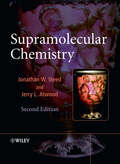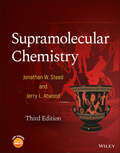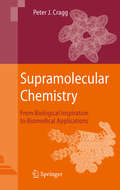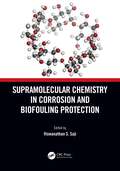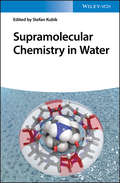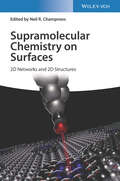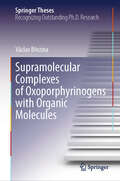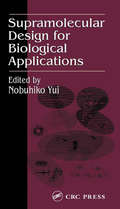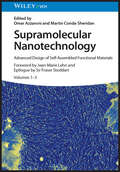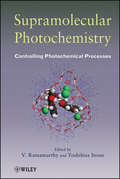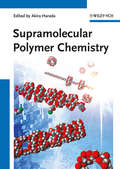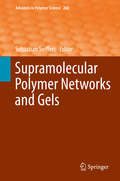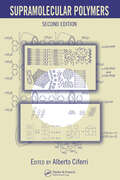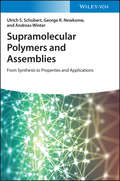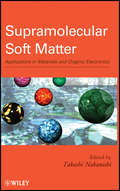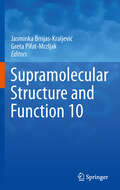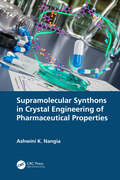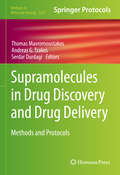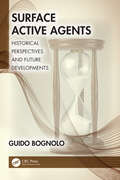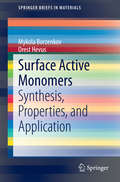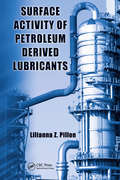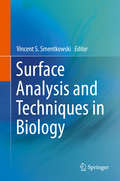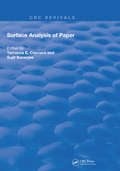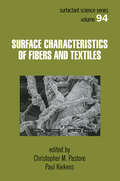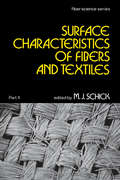- Table View
- List View
Supramolecular Chemistry
by Jonathan W. Steed Jerry L. AtwoodSupramolecular chemistry is 'chemistry beyond the molecule' - the chemistry of molecular assemblies and intermolecular bonds. It is one of today's fastest growing disciplines, crossing a range of subjects from biological chemistry to materials science; and from synthesis to spectroscopy.Supramolecular Chemistry is an up-to-date, integrated textbook that tells the newcomer to the field everything they need to know to get started. Assuming little in the way of prior knowledge, the book covers the concepts behind the subject, its breadth, applications and the latest contemporary thinking in the area. It also includes coverage of the more important experimental and instrumental techniques needed by supramolecular chemists.The book has been thoroughly updated for this second edition. In addition to the strengths of the very popular first edition, this comprehensive new version expands coverage into a broad range of emerging areas. Clear explanations of both fundamental and nascent concepts are supplemented by up-to-date coverage of exciting emerging trends in the literature. Numerous examples and problems are included throughout the book. A system of "key references" allows rapid access to the secondary literature, and of course comprehensive primary literature citations are provided. A selection of the topics covered is listed below.Cation, anion, ion-pair and molecular host-guest chemistryCrystal engineeringTopological entanglementClathratesSelf-assemblyMolecular devicesDendrimersSupramolecular polymersMicrofabricationNanoparticlesChemical emergenceMetal-organic frameworksGelsIonic liquidsSupramolecular catalysisMolecular electronicsPolymorphismGas sorptionAnion-pinteractionsNanochemistrySupramolecular Chemistry is a must for both students new to the field and for experienced researchers wanting to explore the origins and wider context of their work.Review:"At just under 1000 pages, the second edition of Steed and Atwood's Supramolecular Chemistry is the most comprehensive overview of the area available in textbook form...highly recommended."Chemistry World, August 2009
Supramolecular Chemistry
by Jonathan W. Steed Jerry L. AtwoodA one-stop, comprehensive, and thoroughly updated resource for students, professors, and researchers alike Thoroughly revised and updated, the Third Edition of Supramolecular Chemistry delivers a comprehensive and integrated approach to this rapidly evolving and quickly expanding field. Distinguished professors and authors Jonathan Steed and Jerry Atwood provide readers with a broad and exhaustive resource that assumes little in the way of prior knowledge of supramolecular chemistry. Extensive new content on cutting edge research throughout the field including molecular machines and the mechanical bond, mechanochemistry, halogen bonding, and crystal nucleation accompanies full-color imagery and study problems designed to help students understand and apply the principles introduced within the book. Additional material is provided in the supplementary online resources, including solutions to the student exercises and PowerPoint slides of the figures in the book. Supramolecular Chemistry, Third Edition also includes: The latest research and developments reported over the last decade A unique “key references” system that highlights crucial reviews and primary literature A description of key experimental techniques included in accessible “boxes” for the non-expert Exercises and problems for students, complete with online solutions Full-color illustrations and imagery designed to facilitate learning and retention of the key concepts and state-of-the art of the field Perfect for undergraduate and postgraduate students taking courses on supramolecular chemistry, the Third Edition of Supramolecular Chemistry also belongs on the bookshelves of all researchers in this, and any closely related, fields. Academics, in particular postdoctoral students and professors, will benefit significantly from this text.
Supramolecular Chemistry
by Peter J. CraggThe aim of this book is to return to the biomimicry and medicinal potential that inspired many of the early supramolecular chemists and to set it in the context of current advances in the field. Following an overview of supramolecular chemistry, the first section considers the efforts made to synthesize artificial systems that mimic biological entities. The second section addresses the application of supramolecular principles to molecular diagnostics with a particular emphasis on the 'receptor-relayreporter' motif. Many of the examples chosen have clinical importance. The third section takes the clinical diagnostic theme further and demonstrates the therapeutic applications of supramolecular chemistry through photodynamic therapy, drug delivery, and the potential for synthetic peptides to form antibiotic tubes. The short epilogue considers the potential for supramolecular solutions to be found for further challenges in biomimetic and therapeutic chemistry.
Supramolecular Chemistry in Corrosion and Biofouling Protection
by Viswanathan S. SajiSupramolecular chemistry, "the chemistry beyond the molecule", is a fascinating realm of modern science. The design of novel supramolecular structures, surfaces, and techniques are at the forefront of research in different application areas, including corrosion and biofouling protection. A team of international experts provide a comprehensive view of the applications and potential of supramolecular chemistry in corrosion and biofouling prevention. Chapter topics include types and fundamentals of supramolecules, supramolecular polymers and gels, host-guest inclusion compounds, organic-inorganic hybrid materials, metallo-assemblies, cyclodextrins, crown ethers, mesoporous silica and supramolecular structures of graphene and other advances. Additional Features include: Focuses on different aspects of supramolecular chemistry in corrosion and biofouling prevention. Comprehensively covers supramolecular interactions that can provide better corrosion and biofouling protection. Provides the latest developments in self-healing coatings. Explores recent research advancements in the suggested area. Includes case studies specific to industries. The different supramolecular approaches being investigated to control corrosion and biofouling are gathered in one well-organized reference to serve senior undergraduate and graduate students, research students, engineers, and researchers in the fields of corrosion science & engineering, biofouling, and protective coatings.
Supramolecular Chemistry in Water
by Stefan KubikProvides deep insight into the concepts and recent developments in the area of supramolecular chemistry in water Written by experts in their respective field, this comprehensive reference covers various aspects of supramolecular chemistry in water?from fundamental aspects to applications. It provides readers with a basic introduction to the current understanding of the properties of water and how they influence molecular recognition, and examines the different receptor types available in water and the types of substrates that can be bound. It also looks at areas to where they can be applied, such as materials, optical sensing, medicinal imaging, and catalysis. Supramolecular Chemistry in Water offers five major sections that address important topics like water properties, molecular recognition, association and aggregation phenomena, optical detection and imaging, and supramolecular catalysis. It covers chemistry and physical chemistry of water; water-mediated molecular recognition; peptide and protein receptors; nucleotide receptors; carbohydrate receptors; and ion receptors. The book also teaches readers all about coordination compounds; self-assembled polymers and gels; foldamers; vesicles and micelles; and surface-modified nanoparticles. In addition, it provides in-depth information on indicators and optical probes, as well as probes for medical imaging. -Covers, in a timely manner, an emerging area in chemistry that is growing more important every day -Addresses topics such as molecular recognition, aggregation, catalysis, and more -Offers comprehensive coverage of everything from fundamental aspects of supramolecular chemistry in water to its applications -Edited by one of the leading international scientists in the field Supramolecular Chemistry in Water is a one-stop-resource for all polymer chemists, catalytic chemists, biochemists, water chemists, and physical chemists involved in this growing area of research.
Supramolecular Chemistry on Surfaces: 2D Networks and 2D Structures
by Neil R. ChampnessSupramolecular Chemistry on Surfaces 2D Networks and 2D Structures Explore the cutting-edge in 2D chemistry on surfaces and its applications In Supramolecular Chemistry on Surfaces: 2D Networks and 2D Structures, expert chemist Neil R. Champness delivers a comprehensive overview of the rapidly developing field of two-dimensional supramolecular chemistry on surfaces. The book offers explorations of the state-of-the-art in the discipline and demonstrates the potential of the latest advances and the challenges faced by researchers in different areas. The editor includes contributions from leading researchers that address new spectroscopic methods which allow for investigations at a sub-molecular level, opening up new areas of understanding in the field. Included resources also discuss important supramolecular strategies, like hydrogen-bonding, van der Waals interactions, metal-ligand coordination, multicomponent assembly, and more. The book also provides: A thorough introduction to two-dimensional supramolecular chemistry on surfaces Comprehensive explorations of the characterization and interpretation of on-surface chemical reactions studied by ultra-high resolution scanning probe microscopy Practical discussions of complexity in two-dimensional multicomponent assembly, including explorations of coordination bonds and quasicrystalline structures In-depth examinations of covalently bonded organic structures via on-surface synthesis Perfect for polymer chemists, spectroscopists, and materials scientists, Supramolecular Chemistry on Surfaces: 2D Networks and 2D Structures will also earn a place in the libraries of physical and surface chemists, as well as surface physicists.
Supramolecular Complexes of Oxoporphyrinogens with Organic Molecules (Springer Theses)
by Václav BřezinaMacrocyclic oxoporphyrinogen molecules combine the ability to form strong supramolecular complexes with organic compounds and the ability to absorb light. These properties allow high-sensitivity colorimetric detection of acids in solution in the presence of oxoporphyrinogen. Moreover, protonated oxoporphyrinogens show various molecular dynamic processes on the millisecond timescale. This book offers deep analyses of colorimetric, binding and kinetic properties of oxoporphyrinogen-acid complexes. A detailed introduction is given for: theory of supramolecular binding and chemical kinetics; NMR spectroscopy with emphasis on multi-state chemical exchange including derivation of analytical spectral lineshapes; UV/vis spectroscopy and analysis of UV/vis spectra, using singular value decomposition (SVD). Implementation of the derived models in Mathematica is also provided. The experimental part addresses SVD analysis of UV/vis spectra illuminating the effect of protonation on various oxoporphyrinogen derivatives and explaining the colorimetric response. Furthermore, analysis of chemical exchange lineshapes offers insight into the dynamic processes present in protonated oxoporphyrinogens. The various models and techniques described in this book are widely applicable for other systems.
Supramolecular Design for Biological Applications
by Nobuhiko YuiSupramolecular chemistry is the outburst topic of the next generation of science. While the majority of biomedical research efforts to date have centered on utilizing well-known polymeric materials, the recent progress in supramolecular chemistry has introduced a fascinating new field of macromolecular architecture. Supramolecular Design fo
Supramolecular Nanotechnology: Advanced Design of Self-Assembled Functional Materials, 3 Volumes
by Omar Azzaroni Martin Conda‐SheridanSupramolecular Nanotechnology Provides up-to-date coverage of both current knowledge and new developments in the dynamic and interdisciplinary field of supramolecular nanotechnology In recent years, supramolecular nanotechnology has revolutionized research in chemistry, physics, and materials science. These easily manipulated molecular units enable the synthesis of novel nanomaterials for use in a wide range of current and potential applications including electronics, sensors, drug delivery, and imaging. Supramolecular Nanotechnology presents a state-of-the-art overview of functional self-assembling nanomaterials based on organic and polymeric molecules. Featuring contributions by an international panel of experts in the field, this comprehensive volume covers the design of self-assembled materials, their synthesis and diverse fabrication methods, the characterization of supramolecular architectures, and current and emerging applications in chemistry, biology, and medicine. Detailed chapters discuss the synthesis of peptide-based supramolecular structures and polymeric self-assembling materials, their characterization, advanced microscopy techniques, nanostructures made of porphyrins, polyelectrolytes, silica, their application in catalysis and cancer, atomistic and coarse-grained simulations, and more. Presents cutting-edge research on rationally designed, self-assembled supramolecular structures Discusses the impact of supramolecular nanotechnology on current and future research and technology Highlights applications of self-assembled supramolecular systems in catalysis, biomedical imaging, cancer therapies, and regenerative medicine Provides synthetic strategies for preparing the molecular assemblies and various characterization techniques for assessing the supramolecular morphology Describes theoretical modeling and simulation techniques for analyzing supramolecular nanostructures Supramolecular Nanotechnology: Advanced Design of Self-Assembled Functional Materials is essential reading for materials scientists and engineers, polymer and organic chemists, pharmaceutical scientists, molecular physicists and biologists, and chemical engineers.
Supramolecular Photochemistry: Controlling Photochemical Processes (Molecular And Supramolecular Photochemistry Ser. #3)
by Yoshihisa Inoue V. RamamurthyThis is the most updated, comprehensive collection of monographs on all aspects of photochemistry and photophysics related to natural and synthetic, inorganic, organic, and biological supramolecular systems. Supramolecular Photochemistry: Controlling Photochemical Processes addresses reactions in crystals, organized assemblies, monolayers, zeolites, clays, silica, micelles, polymers, dendrimers, organic hosts, supramolecular structures, organic glass, proteins and DNA, and applications of photosystems in confined media. This landmark publication describes the past, present, and future of this growing interdisciplinary area.
Supramolecular Polymer Chemistry
by Akira HaradaPresenting the work of pioneering experts in this exciting field of supramolecular polymer chemistry, this monograph covers an extensive range of applications, including drug delivery and catalysis. It focuses on new structures and phenomena of cyclodextrin-based supramolecular polymers and many other compound classes. While providing a deeper insight in macromolecular recognition and the mechanisms of living systems, this book also introduces fascinating novel phenomena beyond natural systems.
Supramolecular Polymer Networks and Gels
by Sebastian SeiffertThe series Advances in Polymer Science presents critical reviews of the present and future trends in polymer and biopolymer science. It covers all areas of research in polymer and biopolymer science including chemistry, physical chemistry, physics, material science. The thematic volumes are addressed to scientists, whether at universities or in industry, who wish to keep abreast of the important advances in the covered topics. Advances in Polymer Science enjoys a longstanding tradition and good reputation in its community. Each volume is dedicated to a current topic and each review critically surveys one aspect of that topic, to place it within the context of the volume. The volumes typically summarize the significant developments of the last 5 to 10 years and discuss them critically, presenting selected examples, explaining and illustrating the important principles and bringing together many important references of primary literature. On that basis, future research directions in the area can be discussed. Advances in Polymer Science volumes thus are important references for every polymer scientist, as well as for other scientists interested in polymer science - as an introduction to a neighboring field, or as a compilation of detailed information for the specialist. Review articles for the individual volumes are invited by the volume editors. Single contributions can be specially commissioned. Readership: Polymer scientists, or scientists in related fields interested in polymer and biopolymer science, at universities or in industry, graduate students.
Supramolecular Polymers
by Alberto CiferriSupramolecular Polymers, Second Edition details assembly processes and structure-function correlation in natural and synthetic self-assembling materials, focusing on developments occurred over the past five years.The book highlights developments in the synthesis of complex structures, chemical design principles, and theoretical models of
Supramolecular Polymers and Assemblies: From Synthesis to Properties and Applications
by Andreas Winter Ulrich S. Schubert George R. NewkomeExplore modern characterization methods and new applications in this modern overview of supramolecular polymer chemistry Supramolecular Polymers and Assemblies: From Synthesis to Properties and Applications delivers a superlative summary and description of general concepts and definitions in the field. The book offers informative and accessible treatments of crucial concepts like metal-containing compounds, hydrogen bonding, ionic interactions, pi-pi stacking, and more. Characterization remains a primary focus of the book throughout, making it extremely useful for practitioners in the field. Emphasis is also placed on metallo-supramolecular polymers and materials which have found applications in areas like smart or intelligent materials and systems with special photochemical and photophysical properties, like LEDs and solar cells. Applications, including self-healing materials, opto-electronics, sensing, and catalysis are all discussed as well. The book details many of the exciting developments in the field of supramolecular chemistry that have occurred since the 1987 Nobel Prize was awarded to pioneers in this rapidly developing field. Readers will also benefit from the inclusion of: A thorough introduction to supramolecular assemblies based on ionic interactions Explorations of supramolecular polymers based on hydrogen-bonding interactions, metal-to-ligand interactions, p-Electronic interactions, crown-ether recognition, cucurbiturils, and host-guest chemistry of calixarenes A discussion of cyclodextrins in the field of supramolecular polymers Examinations of supramolecular polymers based on the host-guest chemistry of pillarenes, and those formed by orthogonal non-covalent interactions A treatment of the characterization of supramolecular polymers Supramolecular Polymers and Assemblies: From Synthesis to Properties and Applications will earn a place in the libraries of researchers and practitioners of the material science, as well as polymer chemists seeding a one-stop reference for supramolecular polymers.
Supramolecular Soft Matter: Applications in Materials and Organic Electronics
by Takashi NakanishiThe pivotal text that bridges the gap between fundamentals and applications of soft matter in organic electronics Covering an expanding and highly coveted subject area, Supramolecular Soft Matter enlists the services of leading researchers to help readers understand and manipulate the electronic properties of supramolecular soft materials for use in organic opto-electronic devices, such as photovoltaics and field effect transistors, some of the most desired materials for energy conservation. Rather than offering a compilation of current trends in supramolecular soft matter, this book bridges the gap between fundamentals and applications of soft matter in organic electronics in an effort to open new directions in research for applying supramolecular assembly into organic materials while also focusing on the morphological functions originating from the materials' self-assembled architectures. This unique approach distinguishes Supramolecular Soft Matter as a valuable resource for learning to identify concepts that hold promise for the successful development of organic/polymeric electronics for use in real-world applications. Supramolecular Soft Matter: Combines important topics to help supramolecular chemists and organic electronics researchers work together Covers an interdisciplinary field of prime importance to government-supported R&D research Discusses the concepts and perspectives in a dynamic field to aid in the successful development of organic electronics Includes applications for energy conservation like photovoltaics and field effect transistors Teeming with applicable information on both molecular design and synthesis, as well as the development of smart molecular assemblies for organic electronic systems, Supramolecular Soft Matter provides more practical in-depth coverage of this rapidly evolving technology than any other book in its field.
Supramolecular Structure and Function 10
by Jasminka Brnjas-Kraljević Greta Pifat-MrzljakThe book is based on lectures presented on the International Summer School on Biophysics held in Croatia in September 2009. The advantage of the School is that it provides advanced training in very broad scope of areas related to biophysics contrary to other similar schools or workshops that are centered mainly on one topic or technique. In this volume, tenth in the row, the papers in the field of biophysics are presented. The topics are biological phenomena from single protein to macromolecular aggregations structure by using variant physical methods (NMR, EPR, FTIR, Mass Spectrometry, etc.). The interrelationship of supramolecular structures and their functions is enlightened by applications of principals of these physical methods in the biophysical and molecular biology context.
Supramolecular Synthons in Crystal Engineering of Pharmaceutical Properties (xx xx)
by Ashwini K. NangiaThis comprehensive resource skillfully consolidates crystal engineering, the design of organic solids, and supramolecular synthons (i.e., structural hydrogen bond units) to achieve desired pharmaceutical properties, including solubility, dissolution, bioavailability, permeability, particle size, tableting, hydration, and mechanical strength. Covering 30 years of crystal engineering developments and pharmaceutical applications, this book will be a single and complete resource for supramolecular and structural chemists, the crystal engineering community, pharmaceutical scientists, and industrial researchers.Key Features Covers the fundamentals of crystal engineering and supramolecular synthons. Details the challenges of low solubility and low permeability facing oral drug formulations. Explains how heterosynthons provide a rational approach to address and implement solutions. Provides case studies from academic and industrial labs to walk the reader through the actual steps. Explores developments in the scale up and manufacture of crystal forms in pharmaceutical industry.
Supramolecules in Drug Discovery and Drug Delivery: Methods and Protocols (Methods in Molecular Biology #2207)
by Thomas Mavromoustakos Andreas G. Tzakos Serdar DurdagiThis detailed book aims to provide readers with critical information to accomplish the synthesis of nanosystems for the purpose of supramolecular entities complexing with drugs, targeted drug delivery system characterization, as well as the study of the physical-chemical interactions that govern the stability and properties of these systems. Beginning with a collection of chapters on drug delivery platforms such as cyclodextrins, micelles, liposomes, polymeric, nanotubes, and more, the volume continues with coverage of the study of nanotechnology systems using different biophysical techniques such as DSC, ITC, solid and liquid NMR spectroscopy, and electrochemistry. Written for the highly successful Methods in Molecular Biology series, chapters include introductions to their respective topics, lists of the necessary materials and reagents, step-by-step, readily reproducible laboratory protocols, and tips on troubleshooting and avoiding known pitfalls. Authoritative and practical, Supramolecules in Drug Discovery and Drug Delivery: Methods and Protocols serves as an ideal guide for researchers working toward drug delivery mechanisms that can tailor their physical chemical properties and enhance their efficacy, while retaining their structures intact.
Surface Active Agents: Historical Perspectives and Future Developments
by Guido BognoloThe production and use of surface active agents have seen various evolutions over time, yet rarely, if ever, has this information been collated in one place. Covering all surfactant classes in a clear and concise style, from their properties and applications to an overview of the evolution of their production processes, this book is a comprehensive overview of the field. It is both a record of important documents and intellectual property as well as a springboard for possible future developments. Key features: Covers both man-made and natural surfactants Includes abundant references to production processes and developments of intellectual property Provides a complete background to the field of surface active agents today From producers and formulators of surface active agents to professors and students of raw materials, this book is appropriate for both academic courses and industry professionals.
Surface Active Monomers
by Mykola Borzenkov Orest HevusThis brief includes information on the background of and development of synthesis of various types of surface active monomers. The authors explain the importance of utilization of surface active monomers for creation of surface active polymers and the various biomedical applications of such compounds . This brief introduces techniques for the synthesis of novel types of surface active monomers, their colloidal and polymerizable properties and application for needs of medicine and biology.
Surface Activity of Petroleum Derived Lubricants
by Lilianna Z. PillonHundreds of lubricant additives are available industry-wide to improve base stock properties and protect metal surfaces; however, the wrong combination of these commodities can result in substandard performance. Surface Activity of Petroleum Derived Lubricants explains how surface activity is affected by several factors: the interfacial properties
Surface Analysis and Techniques in Biology
by Vincent S. SmentkowskiThis book summarizes the main surface analysis techniques that are being used to study biological specimens/systems. The compilation of chapters in this book highlight the benefits that surface analysis provides. The outer layer of bulk solid or liquid samples is referred to as the surface of the sample/material. At the surface, the composition, microstructure, phase, chemical bonding, electronic states, and/or texture is often different than that of the bulk material. The outer surface is where many material interactions/reactions take place. This is especially true biomaterials which may be fabricated into bio-devices and in turn implanted into tissues and organs. Surfaces of biomaterials (synthetic or modified natural materials) are of critical importance since the surface is typically the only part of the biomaterial/bio-device that comes in contact with the biological system. Analytical techniques are required to characterize the surface of biomaterials and quantify their impact in real-world biological systems. Surface analysis of biological materials started in the 1960's and the number of researchers working in this area have increased very rapidly since then, a number of advances have been made to standard surface analytical instrumentation, and a number of new instruments have been introduced.
Surface Analysis of Paper (Routledge Revivals)
by Terrance E. Conners Sujit BanerjeeFirst published in 1995, Surface Analysis of Paper examines surface analysis techniques from a paper industry perspective and places heavy emphasis on applications. Modern techniques, including ion mass spectrometry, infrared spectroscopy, and optical profilometry are reviewed in a straightforward manner. This new book provides details on widely used methods and instruments, and discusses how they can be used to attain, for example, contour maps of the microscopic constituents on paper surfaces and accurate analyses of the physical properties of paper.Organized into three sections, Surface Analysis of Paper provides thorough coverage of the physical characteristics of paper, and a clear picture of new and emerging analytical methods. Carefully chosen background material on fundamental concepts is included wherever such material assists in understanding the uses of analysis methods. Each chapter contains: An introduction A description of the technique A discussion of the type of information that can be obtained with the particular technique Practical examples to demonstrate the advantages of the technique
Surface Characteristics of Fibers and Textiles
by Paul Kiekens Christopher M. PastoreAn exploration of the surface characteristics of fibres and textiles. It emphasizes how fibre surface affects permeability, stiffness, strength, dyeing, wrinkling, and other performance characteristics to optimize production. It also illustrates methods for developing wrinkle-resistant finishes on fibre surfaces using environmentally friendly techn
Surface Characteristics of Fibers and Textiles: Part Ii: (Fiber Science Ser. #7)
by M. J. SchickThe extraordinary growth in the production and use of man-made fibers over the past fewdecades has focused attention on the surface properties of fibers and textiles. This volumecombines surface science and technology in its presentation of the substantial progressthat has been made in the technology related to the surface characteristics of natural,synthetic, and glass fibers and textiles.Adopting an interdisciplinary approach , the coverage places emphasis upon the wetting,soiling, staining, frictional, and adhesive properties of fibers and fabrics, as well asphenomena related to these properties. The book offers critical reviews which describeexperimental facts, theories, and processes. Symbols are clearly defined in each chapter.Among the subjects covered are the surface properties of glass fibers, soil release, stainand water repellance, friction of fabrics, bonding of nonwovens, and the wetting of fibers.Surface Characteristics of Fibers and Textiles, Part II is an outstanding textbook forcourses dealing with surface chemistry, the mechanical properties of textiles, textiletechnology, and polymer chemistry . It is also a valuable reference book designed to makecurrent knowledge on these subjects accessible to industrial and academic researchers.
